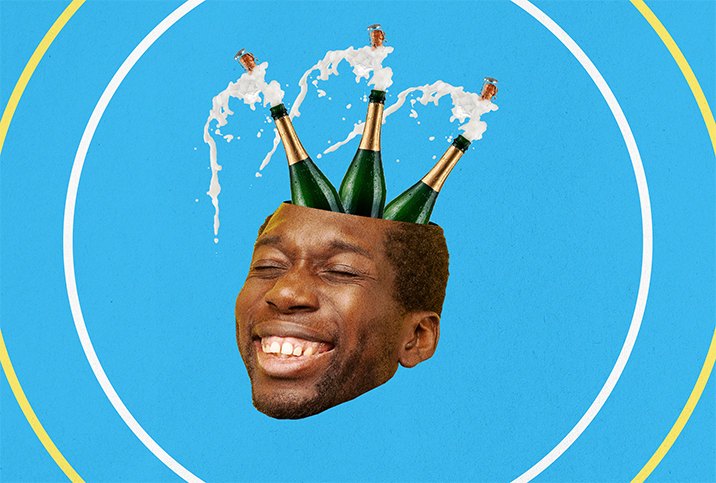The Facts About Orgasms and Sexual Health

The little death. Jouissance. Climaxing. Coming. Whatever you call it, orgasm is, for many, the peak of a sexual experience. People have all different experiences with orgasms: For some, orgasms come easily, while for others, they're more elusive. For some people, orgasm is the primary goal of sex, while others can take them or leave them. Some people have never even had an orgasm, while others have had them since before they knew what they were.
Whatever your own experiences with orgasms, let's get down to the basics that might help you understand and improve your own orgasms as well as your partners'.
What is an orgasm?
An orgasm, defined scientifically, is a peak in sexual pleasure accompanied by a series of rhythmic contractions in the pelvic muscles. The famous sex researchers Masters and Johnson measured that these contractions start out at approximately 0.8-second intervals and gradually decrease in speed and intensity. (In a lab, these contractions are typically measured by putting a probe in the vagina or anus.) Other potential signs of orgasm include vocalizations, flushing, body tension and increased heart rate.
Others, however, use an expanded definition of orgasm that includes any kind of sexual peak or release. Tantra practitioners, for example, talk about "energy orgasms" achieved through breathing or nonsexual movement alone. This can lead to full-body orgasms that aren't centered in the genitals but extend to other parts of the body. Scientists have even theorized that people with vulvas commonly orgasm without the usual contractions. But, for the most part, the scientific definition above is what people mean when they say they've had an orgasm.
What does an orgasm feel like?
Different people describe orgasms differently, but most often, people describe orgasm as involving a build-up and release of tension, a loss of consciousness or control, and a feeling of being finished. Eastern Kentucky University published a study in 2014 of people's descriptions of their own orgasms, and some of the most common sensations people described included intensity, whole-body involvement, pleasure, satisfaction and a sense of "inevitability"—once the orgasm has started, it's not going to stop. Many people say the experience of orgasm is unmistakable, so if you're not sure whether you've had one, there's a good chance you haven't.
Does orgasm differ based on anatomy?
People with vulvas and those with penises tend to describe orgasms in similar ways. In a groundbreaking 1976 study published in the Archives of Sexual Behavior, cisgender men and women wrote descriptions of their orgasms, and then male and female judges (both experts and ordinary people) tried to guess which gender each description belonged to. These judges were not able to distinguish between men's and women's descriptions.
However, one difference commonly cited is that those with vulvas can more easily experience multiple orgasms in one sitting than those with penises. This is because penises typically experience a refractory period after orgasm, during which they're unable to get an erection, which can last from a few minutes to several hours. However, some people with penises can train themselves to have multiple orgasms, often by learning to orgasm without ejaculation. In addition, many people with vulvas experience clitoral hypersensitivity after orgasm and need a break before the clitoris can comfortably be stimulated again, similar to those with penises.
Orgasm vs. ejaculation
For people with penises, orgasm is usually associated with a process called ejaculation—the expulsion of semen through the urethra. Occasionally, however, one will occur without the other. "Dry orgasms"—those without ejaculation—sometimes happen because of various medical conditions or because someone has ejaculated frequently in a short period of time and depleted their supply of semen. More rarely, ejaculation can happen without orgasm due to various psychological, neurological or hormonal issues.
People with vulvas also sometimes experience ejaculation, also known as "squirting." This process can occur during orgasm but can also happen, more commonly than for those with penises, without orgasm. Most often, female ejaculation happens during stimulation of the G-spot—the sensitive area on the upper wall of the vagina.
Health benefits of orgasm
Not only are orgasms enjoyable for most people, but they also have some benefits for physical and mental health. Perhaps most notably, for those with penises, orgasms could help prevent prostate cancer: A 2014 Harvard study found that men who ejaculated more than 20 times per month had a 31 percent lower prostate cancer risk than those who ejaculated only four to seven times a month.
Orgasms have also been associated with increased pain tolerance, so it's not surprising that some find that orgasming helps with pain relief. Research has also linked regular sex and masturbation with improved cardiovascular health, positive body image and enhanced memory. While these benefits may actually exist whether you orgasm or not, it certainly can't hurt.
How to orgasm
For people with penises, orgasm is most typically achieved through stimulation of the penis, though some report orgasming in other ways, such as through anal stimulation. During masturbation, this usually involves stroking the penis up and down. With a partner, this can include oral and manual sex or intercourse. There are also toys to facilitate orgasms in those with penises, such as masturbation sleeves.
Those with vulvas most commonly orgasm through stimulation of the clitoris—the little nub full of nerve endings that exists just above the vaginal opening, where the labia meet. This can involve rubbing your clitoris in circles or side to side or having a partner do this. Other ways people with vulvas frequently orgasm include oral sex and the use of sex toys like vibrators.
Contrary to the way orgasms are often depicted in pornography, most people with vulvas do not regularly orgasm through penetration alone. One 32-study meta-analysis in 2006, titled "The Case of the Female Orgasm: Bias in the Science of Evolution," found that only about one-quarter of cis women consistently orgasmed during intercourse (and given that some people combine intercourse with manual stimulation, the percentage who orgasm through intercourse alone could be lower). Those who want to orgasm during penetration sometimes touch their clitoris simultaneously, have their partner do so or use a couple's vibrator that can be worn during intercourse.
Orgasm problems
Hearing about orgasms and all the great ways people experience them can be discouraging for those who struggle with reaching climax. But these kinds of struggles are very normal. In fact, 11 to 41 percent of women worldwide report difficulty orgasming, and 5 to 10 percent say they've never had an orgasm. Among those with penises, about 5 percent experience delayed ejaculation (inability or difficulty orgasming) at some point in their lives, though some experts believe this number may be increasing. People can have difficulty orgasming for many reasons, including psychological discomfort, relationship issues, medications or not knowing how to orgasm due to poor sex education.
On the flip side, some people (about 30 to 40 percent of those with penises and 3 percent of those with vulvas) experience premature orgasms—those that occur more quickly than the person wants. Often, this occurs due to anxiety or lack of body awareness. Many orgasm problems can be overcome by working with a professional such as a sex therapist or, if appropriate, consulting a doctor.
The orgasm gap
In the U.S. and other parts of the world, men report experiencing more orgasms than women, which is referred to as the orgasm gap. A 2021 study in the Archives of Sexual Behavior found that 95 percent of American heterosexual men reported usually or always orgasming during sexual encounters, compared to 65 percent of straight women. The gap between gay men and lesbians was much smaller: 89 percent versus 86 percent. This teaches us that the orgasm gap is likely related to heterosexual dynamics, such as the prioritization of men's pleasure over women's pleasure and the focus on penetration in heterosexual encounters.
Those looking to combat the orgasm gap in their own relationships can make sure to ask their partners what they need in order to orgasm and incorporate clitoral stimulation if it is wanted, which may mean focusing on activities like cunnilingus and fingering that are often considered "foreplay."
How important are orgasms?
There's a reason so many people are interested in having more or better orgasms: Orgasms are both a lot of fun and helpful for aspects of your physical and mental health. However, the presence or absence of an orgasm doesn't determine whether or not you're having good sex. There are plenty of people who have amazing sex lives without having frequent orgasms. Plus, if you're focused on trying to orgasm, you're not going to be present enough to actually enjoy sex, which is ultimately what leads to orgasm. So, think of orgasms as one part of your sex life to explore and improve, but not the end-all-be-all of a sexual experience.


















